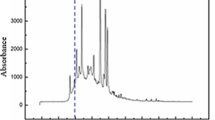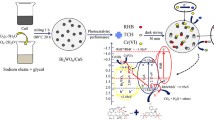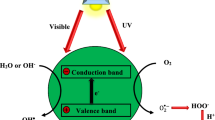Abstract
Highly efficient, low-cost, and portable wastewater treatment and purification solutions are urgently needed for aqueous pollution removal, especially at remote sites. Synergistic photocatalytic (PC) and persulphate (PS) degradation under visible light offers an exceptional alternative for this purpose. In this work, we coupled a TiO2-based PC system with a PS oxidation system into a portable advanced oxidation device for rapid and deep degradation of organic contaminants in wastewater. Using hydrogenation, we fabricated hydrogenated anatase branched-rutile TiO2 nanorod (H-AB@RTNR) photocatalysts which enable the PC degradation to occur under visible light and improve the utilization of solar energy. We also discovered that the addition of PS resulted in the synergistic degradation of tenacious and persistent organics, dramatically improving the extent and kinetics of the degradation. A degradation rate of 100% and a reaction rate constant of 0.0221 min−1 for degrading 1 L rhodamine B (20 mg L−1) were achieved in 120 min in a specially designed thin-layer cell under visible light irradiation. The superior performance of the synergistic PC and PS degradation system was also demonstrated in the degradation of real industrial wastewater. Both remarkable performances can be attributed to the heterophase junction and oxygen vacancies in the photocatalyst that facilitate the catalytic conversion of PS anions into highly active radicals (·SO4− and ·OH). This work suggests that the as proposed synergistic degradation design is a promising solution for building a portable wastewater treatment system.
摘要
本文报道了一种氢化金红石/锐钛矿混晶结构的TiO2薄膜光催化材料(H-AB@RTNR)与过硫酸盐协同降解有机污染物的新方法, 设计了一套薄层式反应器以提高该方法对污染物的降解效率, 建立了可见光光催化剂-过硫酸盐协同净化污水系统. 实验结果表明, 在可见光(λ>420 nm)的照射下, 120分钟内可完全净化1 L浓度 为20 mg L−1的罗丹明B溶液, 反应速率常数达到0.0221 min−1. 在对实际工业废水的处理实验中, 此系统也表现出优异的净化效果. 机理分析表明此系统优异的净化污水性能主要归功于反应中生成的大量硫酸根自由基(·SO4−)和羟基自由基(·OH). 最后本文对降解过程中的中间产物进行了分析, 明确了降解有机物的反应路径.
Similar content being viewed by others
References
Sabri M, Habibi-Yangjeh A, Chand H, et al. Activation of persulfate by novel TiO2/FeOCl photocatalyst under visible light: Facile synthesis and high photocatalytic performance. Separ Purif Tech, 2020, 250: 117268
Li Q, Hou X, Fang Z, et al. Construction of layered h-BN/TiO2 hetero-structure and probing of the synergetic photocatalytic effect. Sci China Mater, 2020, 63: 276–287
Zhao Y, Kang S, Qin L, et al. Self-assembled gels of Fe-chitosan/montmorillonite nanosheets: Dye degradation by the synergistic effect of adsorption and photo-Fenton reaction. Chem Eng J, 2020, 379: 122322
Tang Q, An X, Lan H, et al. Polyoxometalates/TiO2 photocatalysts with engineered facets for enhanced degradation of bisphenol A through persulfate activation. Appl Catal B-Environ, 2020, 268: 118394
Anipsitakis GP, Dionysiou DD. Radical generation by the interaction of transition metals with common oxidants. Environ Sci Technol, 2004, 38: 3705–3712
Li X, Huang X, Xi S, et al. Single cobalt atoms anchored on porous N-doped graphene with dual reaction sites for efficient Fenton-like catalysis. J Am Chem Soc, 2018, 140: 12469–12475
Zu M, Zheng M, Zhang S, et al. Designing robust anatase-branch@hydrogenated-rutile-nanorod TiO2 as accurate and sensitive photoelectrochemical sensors. Sens Actuat B-Chem, 2020, 321: 128504
Liu L, Liu X, Chai Y, et al. Surface modification of TiO2 nanosheets with fullerene and zinc-phthalocyanine for enhanced photo-catalytic reduction under solar-light irradiation. Sci China Mater, 2020, 63: 2251–2260
He J, Du YE, Bai Y, et al. Facile formation of anatase/rutile TiO2 nanocomposites with enhanced photocatalytic activity. Molecules, 2019, 24: 2996
Zhou T, Chen S, Li L, et al. Carbon quantum dots modified anatase/rutile TiO2 photoanode with dramatically enhanced photoelectrochemical performance. Appl Catal B-Environ, 2020, 269: 118776
Ai C, Xie P, Zhang X, et al. Explaining the enhanced photoelectrochemical behavior of highly ordered TiO2 nanotube arrays: Anatase/rutile phase junction. ACS Sustain Chem Eng, 2019, 7: 5274–5282
Zhong Y, Ma S, Chen K, et al. Controlled growth of plasmonic heterostructures and their applications. Sci China Mater, 2020, 63: 1398–1417
Miyagi T, Kamei M, Mitsuhashi T, et al. Charge separation at the rutile/anatase interface: a dominant factor of photocatalytic activity. Chem Phys Lett, 2004, 390: 399–402
Kawahara T, Konishi Y, Tada H, et al. A patterned TiO2(anatase)/TiO2(rutile) bilayer-type photocatalyst: Effect of the anatase/rutile junction on the photocatalytic activity. Angew Chem, 2002, 114: 2935–2937
Scanlon DO, Dunnill CW, Buckeridge J, et al. Band alignment of rutile and anatase TiO2. Nat Mater, 2013, 12: 798–801
Wang X, Mayrhofer L, Hoefer M, et al. Facile and efficient atomic hydrogenation enabled black TiO2 with enhanced photo-electrochemical activity via a favorably low-energy-barrier pathway. Adv Energy Mater, 2019, 9: 1900725
Xiao F, Zhou W, Sun B, et al. Engineering oxygen vacancy on rutile TiO2 for efficient electron-hole separation and high solar-driven photocatalytic hydrogen evolution. Sci China Mater, 2018, 61: 822–830
Pan J, Dong Z, Wang B, et al. The enhancement of photocatalytic hydrogen production via Ti3+ self-doping black TiO2/g-C3N4 hollow core-shell nano-heterojunction. Appl Catal B-Environ, 2019, 242: 92–99
Lu Y, Yin WJ, Peng KL, et al. Self-hydrogenated shell promoting photocatalytic H2 evolution on anatase TiO2. Nat Commun, 2018, 9: 2752
Zhuang G, Chen Y, Zhuang Z, et al. Oxygen vacancies in metal oxides: Recent progress towards advanced catalyst design. Sci China Mater, 2020, 63: 2089–2118
Bhatkhande DS, Pangarkar VG, Beenackers AACM. Photocatalytic degradation for environmental applications—A review. J Chem Technol Biotechnol, 2002, 77: 102–116
Zhao W, Wang X, Ma L, et al. WO3/p-type-GR layered materials for promoted photocatalytic antibiotic degradation and device for mechanism insight. Nanoscale Res Lett, 2019, 14: 146
Li H, Long B, Ye KH, et al. A recyclable photocatalytic tea-bag-like device model based on ultrathin Bi/C/BiOX (X = Cl, Br) nanosheets. Appl Surf Sci, 2020, 515: 145967
Wang Y, Zu M, Zhou X, et al. Designing efficient TiO2-based photoelectrocatalysis systems for chemical engineering and sensing. Chem Eng J, 2020, 381: 122605
Zhang S, Zhang S, Peng B, et al. High performance hydrogenated TiO2 nanorod arrays as a photoelectrochemical sensor for organic compounds under visible light. Electrochem Commun, 2014, 40: 24–27
Lin J, Sun T, Li M, et al. More efficiently enhancing photocatalytic activity by embedding Pt within anatase-rutile TiO2 heterophase junction than exposing Pt on the outside surface. J Catal, 2019, 372: 8–18
Wang CC, Chou PH. Effects of various hydrogenated treatments on formation and photocatalytic activity of black TiO2 nanowire arrays. Nanotechnology, 2016, 27: 325401
Chen S, Li D, Liu Y, et al. Morphology-dependent defect structures and photocatalytic performance of hydrogenated anatase TiO2 nanocrystals. J Catal, 2016, 341: 126–135
Ye K, Li K, Lu Y, et al. An overview of advanced methods for the characterization of oxygen vacancies in materials. TrAC Trends Anal Chem, 2019, 116: 102–108
Zhang X, Hu W, Zhang K, et al. Ti3+ self-doped black TiO2 nanotubes with mesoporous nanosheet architecture as efficient solar-driven hydrogen evolution photocatalysts. ACS Sustain Chem Eng, 2017, 5: 6894–6901
Chen X, Liu L, Huang F. Black titanium dioxide (TiO2) nanomaterials. Chem Soc Rev, 2015, 44: 1861–1885
Chen X, Liu L, Yu PY, et al. Increasing solar absorption for photocatalysis with black hydrogenated titanium dioxide nanocrystals. Science, 2011, 331: 746–750
Hu J, Zhang S, Cao Y, et al. Novel highly active anatase/rutile TiO2 photocatalyst with hydrogenated heterophase interface structures for photoelectrochemical water splitting into hydrogen. ACS Sustain Chem Eng, 2018, 6: 10823–10832
Tauc J. Optical properties and electronic structure of amorphous Ge and Si. Mater Res Bull, 1968, 3: 37–46
Reyes-Coronado D, Rodríguez-Gattorno G, Espinosa-Pesqueira ME, et al. Phase-pure TiO2 nanoparticles: anatase, brookite and rutile. Nanotechnology, 2008, 19: 145605
Yan J, Han X, Qian J, et al. Preparation of 2D graphitic carbon nitride nanosheets by a green exfoliation approach and the enhanced photocatalytic performance. J Mater Sci, 2017, 52: 13091–13102
Asadzadeh-Khaneghah S, Habibi-Yangjeh A, Seifzadeh D. Graphitic carbon nitride nanosheets coupled with carbon dots and BiOI nanoparticles: Boosting visible-light-driven photocatalytic activity. J Taiwan Institute Chem Engineers, 2018, 87: 98–111
Li K, Lu X, Zhang Y, et al. Bi3TaO7/Ti3C2 heterojunctions for enhanced photocatalytic removal of water-borne contaminants. Environ Res, 2020, 185: 109409
Isari AA, Payan A, Fattahi M, et al. Photocatalytic degradation of rhodamine B and real textile wastewater using Fe-doped TiO2 anchored on reduced graphene oxide (Fe-TiO2/rGO): characterization and feasibility, mechanism and pathway studies. Appl Surf Sci, 2018, 462: 549–564
Acknowledgements
This research was supported by Griffith University PhD scholarships, the National Natural Science Foundation of China (22078118), and the Natural Science Foundation of Guangdong Province (2019A1515011138).
Author information
Authors and Affiliations
Contributions
Author contributions Zu M, Zhang SS and Zhang SQ conceived the idea, designed and developed the experimental plan. Zu M performed the experiments, collected and processed the data, and wrote the manuscript. All the authors discussed the results, analyzed and interpreted the data, and participated in the preparation of the manuscript.
Corresponding authors
Ethics declarations
Conflict of interest The authors declare that they have no conflict of interest.
Additional information
Meng Zu is currently a PhD student at the Centre for Clean Environment and Energy, School of Environment and Science, Griffith University, Australia. He received his Master degree from the Department of Civil and Environmental Engineering, Cornell University in 2016. His research interests include the design and development of functional nanomaterials for photoelectrocatalytic sensing and treatment of aquatic pollutants.
Shengsen Zhang obtained his PhD degree from South China University of Technology, China in 2012. He is now an associate professor at the College of Materials and Energy, South China Agricultural University, China. His research interests include the synthesis, modification, and characterization of nanostructured materials for wastewater purification, sensing, and energy conversion.
Shanqing Zhang obtained his PhD degree in electrochemistry in 2001 at Griffith University, Australia. He is now a professor at Griffith University. His research interests include energy conversion, energy storage, and environmental monitoring.
Supporting information
40843_2020_1599_MOESM1_ESM.pdf
Portable wastewater treatment system based on synergistic photocatalytic and persulphate degradation under visible light
Rights and permissions
About this article
Cite this article
Zu, M., Zhang, S., Liu, C. et al. Portable wastewater treatment system based on synergistic photocatalytic and persulphate degradation under visible light. Sci. China Mater. 64, 1952–1963 (2021). https://doi.org/10.1007/s40843-020-1599-2
Received:
Accepted:
Published:
Issue Date:
DOI: https://doi.org/10.1007/s40843-020-1599-2




